AW Insect Book: Mantids (Order: Mantodea)
Upload your picture of mantid and add a description underneath. Please only do one species per post.
All entries will be edited and updated (additional photos and information will be added by moderators). New entries will be posted according to taxonomic order and the post date does not reflect the actual date of new posts.
AW Insect Book: Mantids (Mantodea) Pics & Descriptions
Moderator: Klipspringer
Index to Mantids (Mantodea)
Mantids (Mantodea)

Superfamily Chroicopteroidea
Chroicopteridae
Dystacta alticeps Leaf Mantid viewtopic.php?p=500307#p500307
Ligariella trigonalis Ground Mantid viewtopic.php?p=530559#p530559
Bisanthe Mantis viewtopic.php?p=530397#p530397
Superfamily Eremiaphiloidea
Eremiaphilidae
Subfamily Iridinae
Episcopomantis chalybea Double-coned Grass Mantid viewtopic.php?f=247&t=3220&p=172694#p172694
Subfamily Tarachodinae
Antistia identification viewtopic.php?f=247&t=3220&p=162013#p162013
Antistia sp. Bark Mantid viewtopic.php?f=247&t=3220&p=172658#p172658
Galepsus sp. Tarachodid Mantis viewtopic.php?p=530285#p530285
Tarachodes lucubrans Lucubrating Mantis viewtopic.php?p=530868#p530868
Tarachodes sanctus Bark Mantid https://www.africawild-forum.com/viewto ... 53#p528153
Rivetinidae
Subfamily Rivetininae
Ischnomantis fatiloqua viewtopic.php?p=530526#p530526
Superfamily Galinthiadoidea
Galinthiadidae
Harpagomantis tricolor Flower Mantid https://www.africawild-forum.com/viewto ... 91#p446891
Superfamily Holocoryphoidea
Hoplocoryphidae
Hoplocorypha cf macra Large African Stick Mantis viewtopic.php?p=530587#p530587
Hoplocorypha cf nana Small African Stick Mantis viewtopic.php?p=530586#p530586
Hoplocorypha cf nana Small African Stick Mantis Nymph viewtopic.php?p=530562#p530562
Hoplocoryphella grandis Hammerhead Mantid viewtopic.php?p=245291#p245291
Superfamily Hymenopoidea
Empusidae
Empusa guttula Cone-headed Mantid viewtopic.php?p=244009#p244009
Idolomorpha dentifrons Cone-headed Mantid viewtopic.php?f=247&t=3220&p=143359#p156920
Hymenopodidae
Subfamily Acromantinae
Tribe Otomantini
Oxypiloidea tridens Bark Mantid viewtopic.php?p=501837#p501837
Subfamily Phyllocraniinae
Phyllocrania paradoxa Common Ghost Mantis viewtopic.php?p=314526#p314526
Superfamily Mantoidea
Deroplatyidae
Subfamily Popinae
Danuria (Danuria) thunbergi Giant Grass Mantis viewtopic.php?p=501204#p501204
Popa spurca spurca African Stick Mantis viewtopic.php?p=213851#p213851
Mantidae
Subfamily Omomantinae
Omomantis zebrata Zebra Mantid viewtopic.php?p=268233#p268233
Subfamily Tenoderinae
Polyspilota aeruginosa Flag Mantis (Nymph) viewtopic.php?p=487756#p487756
Polyspilota aeruginosa Flag Mantis viewtopic.php?p=499958#p499958
Sphodromantis gastrica Common Green Mantid viewtopic.php?f=247&t=3220&p=143359#p143359
Superfamily Miomantoidea
Miomantidae
Subfamily Miomantinae
Miomantis sp. African Mantis viewtopic.php?p=530396#p530396

Superfamily Chroicopteroidea
Chroicopteridae
Dystacta alticeps Leaf Mantid viewtopic.php?p=500307#p500307
Ligariella trigonalis Ground Mantid viewtopic.php?p=530559#p530559
Bisanthe Mantis viewtopic.php?p=530397#p530397
Superfamily Eremiaphiloidea
Eremiaphilidae
Subfamily Iridinae
Episcopomantis chalybea Double-coned Grass Mantid viewtopic.php?f=247&t=3220&p=172694#p172694
Subfamily Tarachodinae
Antistia identification viewtopic.php?f=247&t=3220&p=162013#p162013
Antistia sp. Bark Mantid viewtopic.php?f=247&t=3220&p=172658#p172658
Galepsus sp. Tarachodid Mantis viewtopic.php?p=530285#p530285
Tarachodes lucubrans Lucubrating Mantis viewtopic.php?p=530868#p530868
Tarachodes sanctus Bark Mantid https://www.africawild-forum.com/viewto ... 53#p528153
Rivetinidae
Subfamily Rivetininae
Ischnomantis fatiloqua viewtopic.php?p=530526#p530526
Superfamily Galinthiadoidea
Galinthiadidae
Harpagomantis tricolor Flower Mantid https://www.africawild-forum.com/viewto ... 91#p446891
Superfamily Holocoryphoidea
Hoplocoryphidae
Hoplocorypha cf macra Large African Stick Mantis viewtopic.php?p=530587#p530587
Hoplocorypha cf nana Small African Stick Mantis viewtopic.php?p=530586#p530586
Hoplocorypha cf nana Small African Stick Mantis Nymph viewtopic.php?p=530562#p530562
Hoplocoryphella grandis Hammerhead Mantid viewtopic.php?p=245291#p245291
Superfamily Hymenopoidea
Empusidae
Empusa guttula Cone-headed Mantid viewtopic.php?p=244009#p244009
Idolomorpha dentifrons Cone-headed Mantid viewtopic.php?f=247&t=3220&p=143359#p156920
Hymenopodidae
Subfamily Acromantinae
Tribe Otomantini
Oxypiloidea tridens Bark Mantid viewtopic.php?p=501837#p501837
Subfamily Phyllocraniinae
Phyllocrania paradoxa Common Ghost Mantis viewtopic.php?p=314526#p314526
Superfamily Mantoidea
Deroplatyidae
Subfamily Popinae
Danuria (Danuria) thunbergi Giant Grass Mantis viewtopic.php?p=501204#p501204
Popa spurca spurca African Stick Mantis viewtopic.php?p=213851#p213851
Mantidae
Subfamily Omomantinae
Omomantis zebrata Zebra Mantid viewtopic.php?p=268233#p268233
Subfamily Tenoderinae
Polyspilota aeruginosa Flag Mantis (Nymph) viewtopic.php?p=487756#p487756
Polyspilota aeruginosa Flag Mantis viewtopic.php?p=499958#p499958
Sphodromantis gastrica Common Green Mantid viewtopic.php?f=247&t=3220&p=143359#p143359
Superfamily Miomantoidea
Miomantidae
Subfamily Miomantinae
Miomantis sp. African Mantis viewtopic.php?p=530396#p530396
- nan
- Posts: 26447
- Joined: Thu May 31, 2012 9:41 pm
- Country: Switzerland
- Location: Central Europe
- Contact:
Re: AW Insect Book: Mantids (Mantodea) Pics & Descriptions
Common Green Mantis Sphodromantis gastrica
Superfamily Mantoidea. Family Mantidae. Subfamily Tenoderinae. Tribe Paramantini.

Female hanging upside down, Kruger National Park, Mopani camp © Lisbeth





Kruger National Park (March)
Description
Large (body length 55 mm), robust and bright green, usually with white spot near anterior corner of each fore wing.
A slow-moving, predatory insect, it sits back on its hind legs holding its front legs out together as if praying.
The raptorial forelegs are their defining feature and African mantises use them to capture prey and defend themselves from predators. They are robust insects 1–17 cm in length. They have long, slender walking legs used for lunging. They are green or brown in colour. The African mantis has whitish spots or stripes in the anterior part or the flank of the abdomen on each side of the fore wing. It has a very mobile triangular head that can turn 180° and large compound eyes set up in the head’s corners, with a visual range of 2–15 m. The binocular vision enables them to judge distance to prey and strike with great speed and accuracy. The prothorax, first part of the thorax section between the head and the abdomen, is very elongated and narrow. Females and males can be distinguished based on the number of abdominal segments – females have six and males have eight abdominal segments. Nymphs lack wings and curl the abdomen over the body. The colouration and pattern in nymphs is very different from adults and they are often mistaken for ants during early stages of development.
Distribution
Found in South Africa, Namibia, Botswana, Zimbabwe, Zambia, Democratic Republic of Congo, and East Africa.
Biology
Green Mantids are hemimetabolous insects, they go through incomplete development (without pupal stage). Nymphs do not have fully developed wings. They are easily recognized by the bright green colour and the abdomen curled up over the body.
They are ambush predators that feed on a variety of insects, including crickets, flies, grasshoppers and moths. Larger species prey on frogs, lizards, fish and even rodents. When they are about to feed, praying mantises lie in wait with the raptorial fore legs raised. However, in some instances, praying mantises would feed on one another.
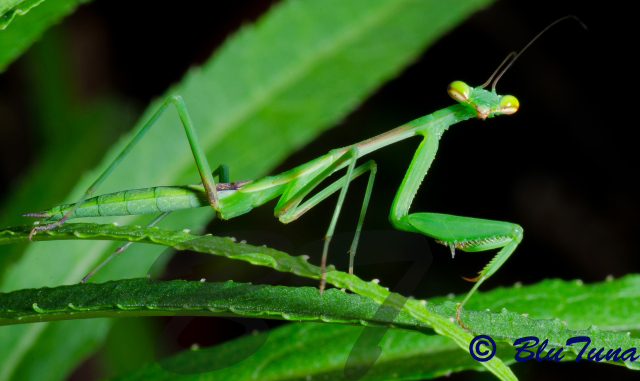 Nymph © BluTuna
Nymph © BluTuna
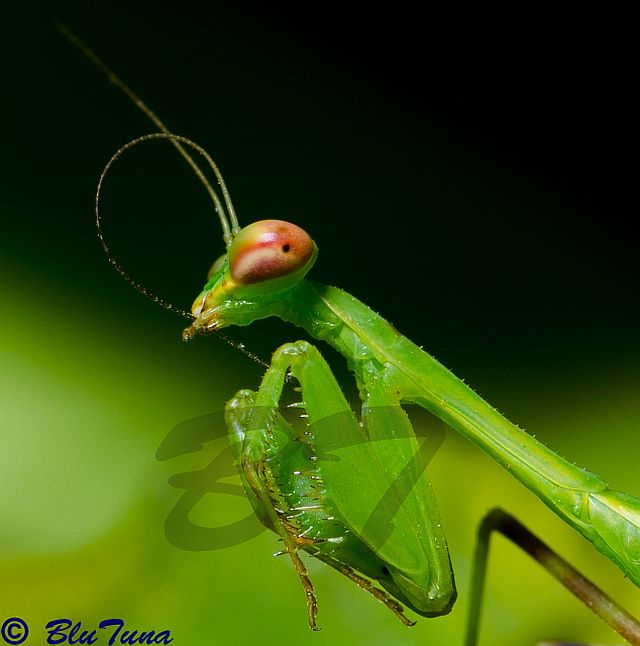 Nymph © BluTuna
Nymph © BluTuna
 Nymph © BluTuna
Nymph © BluTuna
Garden in Johannesburg
Links:
http://mantodea.speciesfile.org/Common/ ... ID=1184056
Jacana Education: Lowveld and Kruger Guide; SANBI
Superfamily Mantoidea. Family Mantidae. Subfamily Tenoderinae. Tribe Paramantini.
Female hanging upside down, Kruger National Park, Mopani camp © Lisbeth





Kruger National Park (March)
Description
Large (body length 55 mm), robust and bright green, usually with white spot near anterior corner of each fore wing.
A slow-moving, predatory insect, it sits back on its hind legs holding its front legs out together as if praying.
The raptorial forelegs are their defining feature and African mantises use them to capture prey and defend themselves from predators. They are robust insects 1–17 cm in length. They have long, slender walking legs used for lunging. They are green or brown in colour. The African mantis has whitish spots or stripes in the anterior part or the flank of the abdomen on each side of the fore wing. It has a very mobile triangular head that can turn 180° and large compound eyes set up in the head’s corners, with a visual range of 2–15 m. The binocular vision enables them to judge distance to prey and strike with great speed and accuracy. The prothorax, first part of the thorax section between the head and the abdomen, is very elongated and narrow. Females and males can be distinguished based on the number of abdominal segments – females have six and males have eight abdominal segments. Nymphs lack wings and curl the abdomen over the body. The colouration and pattern in nymphs is very different from adults and they are often mistaken for ants during early stages of development.
Distribution
Found in South Africa, Namibia, Botswana, Zimbabwe, Zambia, Democratic Republic of Congo, and East Africa.
Biology
Green Mantids are hemimetabolous insects, they go through incomplete development (without pupal stage). Nymphs do not have fully developed wings. They are easily recognized by the bright green colour and the abdomen curled up over the body.
They are ambush predators that feed on a variety of insects, including crickets, flies, grasshoppers and moths. Larger species prey on frogs, lizards, fish and even rodents. When they are about to feed, praying mantises lie in wait with the raptorial fore legs raised. However, in some instances, praying mantises would feed on one another.
 Nymph © BluTuna
Nymph © BluTuna Nymph © BluTuna
Nymph © BluTuna Nymph © BluTuna
Nymph © BluTunaGarden in Johannesburg
Links:
http://mantodea.speciesfile.org/Common/ ... ID=1184056
Jacana Education: Lowveld and Kruger Guide; SANBI
Kgalagadi lover… for ever
https://safrounet.piwigo.com/
https://safrounet.piwigo.com/
Re: AW Insect Book: Mantids (Mantodea) Pics & Descriptions
Cone-headed Mantid Idolomorpha dentifrons
Superfamily Hymenopoidea. Family Empusidae. Subfamily Empusinae. Tribe Empusini
The family Empusidae is a small lineage of mantids, with only 28 described species found mostly in drier regions of Africa and a handful of additional species in southern Europe and SE Asia. The largest mantids are found in the family Empusidae. Empusids are slender and are identified by the spines on their protibia which have alternatively one long spine and two to four shorter spines. They also have leaf-like lobes on the femora.
Male empusids are unusual in having pectinate antennae (comb-like), the kind usually seen in silk moths and other insects with well-developed pheromonal communication, where the female emits sex pheromones and males follow the faint scent trail. Not surprisingly, such behavior was recently demonstrated to be present in empusids.
Two main body types are common – they are either thin and stick-like (the genera Empusa, Hemiempusa, and Idolomorpha) or, while still being rather spindly, the body is covered with large lobes and flaps, making them excellent mimics of dried, shriveled leaves.
 © BluTuna
© BluTuna
Kruger National Park
 © BluTuna
© BluTuna
Female
 © BluTuna
© BluTuna
The fore femora have a specialized grooming device (“femoral brush”).
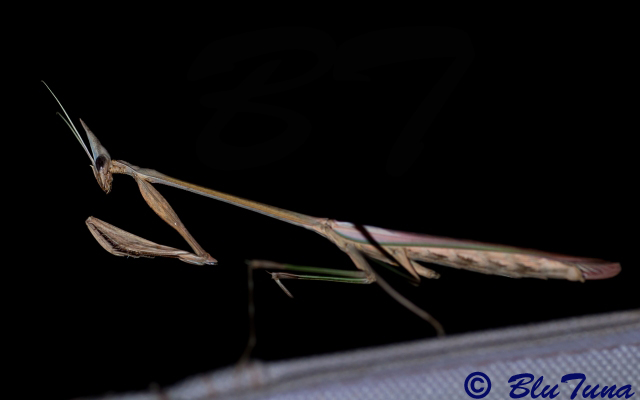 © BluTuna
© BluTuna
Kruger National Park, Balule camp
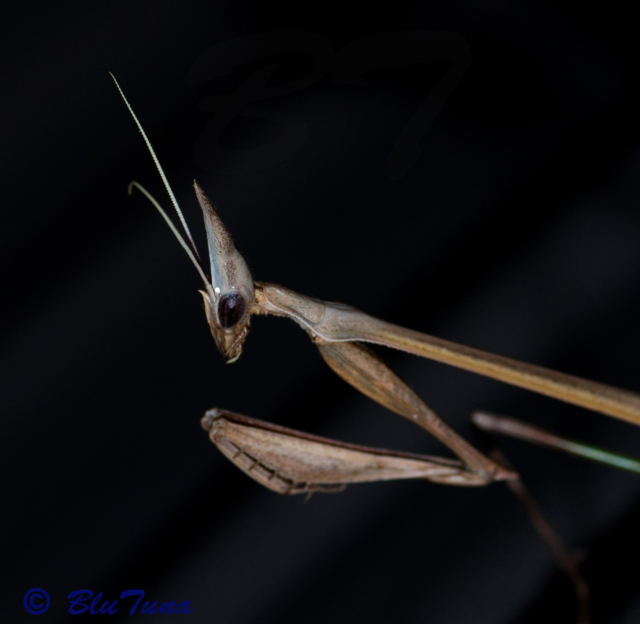 © BluTuna
© BluTuna
Female
Links:
Checklist: The Empusid Praying Mantises (Mantodea: Empusidae) of South Africa; Head Shapes in Mantids (in: Frederick R. Prete. The Praying Mantids)
http://mantodea.speciesfile.org/Common/ ... ID=1182374
Superfamily Hymenopoidea. Family Empusidae. Subfamily Empusinae. Tribe Empusini
The family Empusidae is a small lineage of mantids, with only 28 described species found mostly in drier regions of Africa and a handful of additional species in southern Europe and SE Asia. The largest mantids are found in the family Empusidae. Empusids are slender and are identified by the spines on their protibia which have alternatively one long spine and two to four shorter spines. They also have leaf-like lobes on the femora.
Male empusids are unusual in having pectinate antennae (comb-like), the kind usually seen in silk moths and other insects with well-developed pheromonal communication, where the female emits sex pheromones and males follow the faint scent trail. Not surprisingly, such behavior was recently demonstrated to be present in empusids.
Two main body types are common – they are either thin and stick-like (the genera Empusa, Hemiempusa, and Idolomorpha) or, while still being rather spindly, the body is covered with large lobes and flaps, making them excellent mimics of dried, shriveled leaves.
 © BluTuna
© BluTunaKruger National Park
 © BluTuna
© BluTunaFemale
 © BluTuna
© BluTunaThe fore femora have a specialized grooming device (“femoral brush”).
 © BluTuna
© BluTunaKruger National Park, Balule camp
 © BluTuna
© BluTunaFemale
Links:
Checklist: The Empusid Praying Mantises (Mantodea: Empusidae) of South Africa; Head Shapes in Mantids (in: Frederick R. Prete. The Praying Mantids)
http://mantodea.speciesfile.org/Common/ ... ID=1182374
Hunting cannot be considered a sport as all contestants in a sport should know they are playing the game!
Re: AW Insect Book: Mantids (Mantodea) Pics & Descriptions
Identification Antistia spp
Photos of museum specimens
Antistia vicina Male (from Olifantshoek, Northern Cape)
https://specimens.mantodearesearch.com/specimen/1670
Antistia vicina Male (from Olifantshoek, Northern Cape)
https://specimens.mantodearesearch.com/specimen/1671
Links:
https://www.jstor.org/stable/3503537?se ... b_contents
https://www.zobodat.at/pdf/ANNA_100B_0019-0059.pdf
https://www.jstor.org/stable/41767094?s ... b_contents
Photos of museum specimens
Antistia vicina Male (from Olifantshoek, Northern Cape)
https://specimens.mantodearesearch.com/specimen/1670
Antistia vicina Male (from Olifantshoek, Northern Cape)
https://specimens.mantodearesearch.com/specimen/1671
Links:
https://www.jstor.org/stable/3503537?se ... b_contents
https://www.zobodat.at/pdf/ANNA_100B_0019-0059.pdf
https://www.jstor.org/stable/41767094?s ... b_contents
Re: AW Insect Book: Mantids (Mantodea) Pics & Descriptions
Bark Mantid Antistia sp. possibly Antistia vicina
Superfamily Eremmiaphiloidea. Family Eremiaphilidae. Family Tarachodidae. Subfamily Tarachodinae. Tribe Tarachodini. Subtribe Antistiina
There are 4 similar looking Antistia species found in South Africa. Antistia parva and Antistia vicina are recorded from the Northern Cape.
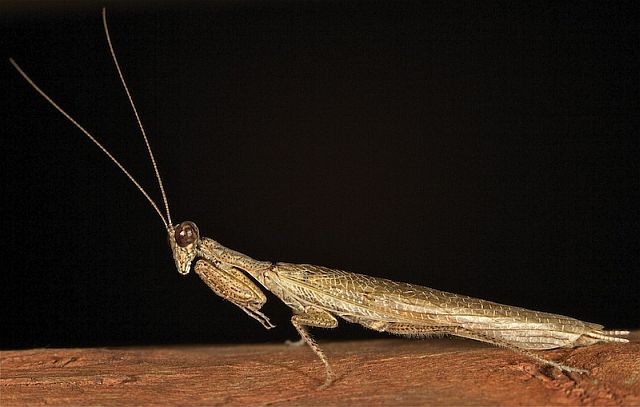
When the raptorial leg is folded at rest or prior to striking, the ventral surfaces of tibia and femur adjoin and their spines interlock.

Attracted to the outdoor light at KTC in Kgalagadi Transfrontier Park in Nov. 2013
Description
Head large, almost twice as broad as the supracoxial dilation. Eyes large and protruding.
Frontal scutellum 1.7 to 1.9 times as long as it is high, with a slightly arched superior margin.
Pronotum with supracoxal dilation, 2 to 2.2 times as wide as long, metazone 1.7 to 1.8 the size of the prozone.
Forelegs slender, femora ochre with black speckling externally, armed with 4 external spines, the first two being closer together, tibia armed with 9-10 external spines. Median and hind legs covered in long, sparse hairs.
Wings greatly protruding over the abdomen apex. Fore wings (= tegmen or elytra) 4.2 to 4.4 the length of the pronotum, translucent with dark brown veins and without a small dark preapical band in the dicoidal area. Hind wings hyaline without dark preapical band.
Size: body length 22 to 24 mm; pronotum length 4.2 to 4.3 mm, 2 to 2.1 mm wide; elytra length 18.2 - 18.5 mm.
Differential diagnosis:
A. vicina can be told from the other species in the genus by the lack of dark patches (dark preapical band) on the the elytra and hind wings.
A. maculipennis-like dark wing markings can also occur in A. vicina, but are less pronounced and paler if present.
Distribution
South Africa (Northern Cape) and Namibia.

Their head is triangular and extraordinarily mobile with large compound eyes set very high on the upper corners and three simple eyes called ocelli on top of the head (between the compound eyes).
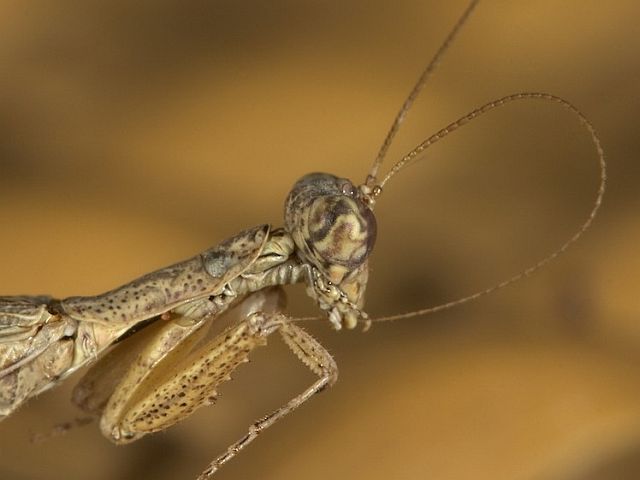
Most mantids sit quietly and wait for prey to come within reach, but a few species actually chase down their victims. After feeding, they always spend a great deal of time grooming. They use their forelegs to wipe their eyes, heads, and antennae.
Links:
http://mantodea.speciesfile.org/Common/ ... ID=1185188
https://www.zobodat.at/pdf/ANNA_100B_0019-0059.pdf
Superfamily Eremmiaphiloidea. Family Eremiaphilidae. Family Tarachodidae. Subfamily Tarachodinae. Tribe Tarachodini. Subtribe Antistiina
There are 4 similar looking Antistia species found in South Africa. Antistia parva and Antistia vicina are recorded from the Northern Cape.

When the raptorial leg is folded at rest or prior to striking, the ventral surfaces of tibia and femur adjoin and their spines interlock.

Attracted to the outdoor light at KTC in Kgalagadi Transfrontier Park in Nov. 2013
Description
Head large, almost twice as broad as the supracoxial dilation. Eyes large and protruding.
Frontal scutellum 1.7 to 1.9 times as long as it is high, with a slightly arched superior margin.
Pronotum with supracoxal dilation, 2 to 2.2 times as wide as long, metazone 1.7 to 1.8 the size of the prozone.
Forelegs slender, femora ochre with black speckling externally, armed with 4 external spines, the first two being closer together, tibia armed with 9-10 external spines. Median and hind legs covered in long, sparse hairs.
Wings greatly protruding over the abdomen apex. Fore wings (= tegmen or elytra) 4.2 to 4.4 the length of the pronotum, translucent with dark brown veins and without a small dark preapical band in the dicoidal area. Hind wings hyaline without dark preapical band.
Size: body length 22 to 24 mm; pronotum length 4.2 to 4.3 mm, 2 to 2.1 mm wide; elytra length 18.2 - 18.5 mm.
Differential diagnosis:
A. vicina can be told from the other species in the genus by the lack of dark patches (dark preapical band) on the the elytra and hind wings.
A. maculipennis-like dark wing markings can also occur in A. vicina, but are less pronounced and paler if present.
Distribution
South Africa (Northern Cape) and Namibia.

Their head is triangular and extraordinarily mobile with large compound eyes set very high on the upper corners and three simple eyes called ocelli on top of the head (between the compound eyes).

Most mantids sit quietly and wait for prey to come within reach, but a few species actually chase down their victims. After feeding, they always spend a great deal of time grooming. They use their forelegs to wipe their eyes, heads, and antennae.
Links:
http://mantodea.speciesfile.org/Common/ ... ID=1185188
https://www.zobodat.at/pdf/ANNA_100B_0019-0059.pdf
Re: AW Insect Book: Mantids (Mantodea) Pics & Descriptions
Double-coned Grass Mantid Episcopomantis chalybea
Superfamily Eremiaphiloidea. Family Eremiaphilidae. Subfamily Iridinae. Tribe Iridini

Habitat / Range
Vegetation in drier regions.
Free State, Gauteng and Northern Province, to East Africa.
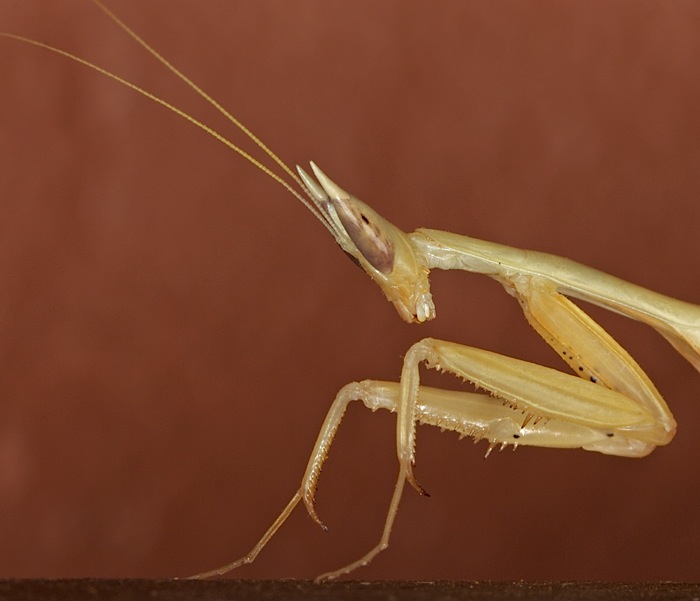

Attracted to the entrance light at KK in KTP Nov. 2012
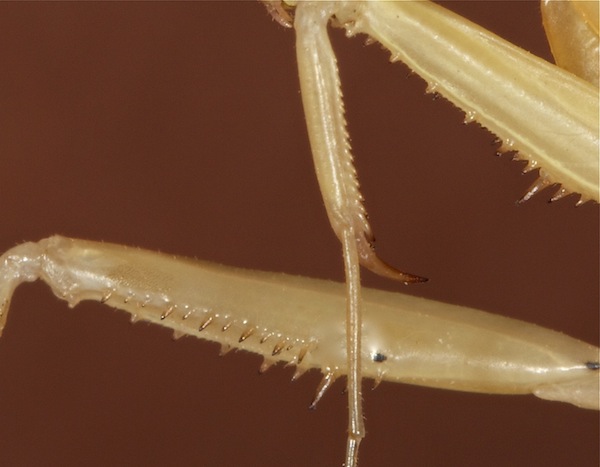
Prey and prey capture
Mantids have fierce predatory habits. They have excellent vision and extremely quick reflexes and are able to strike at and successfully capture insect prey in as little as one-twentieth of a second. They are well equipped to carry out their deadly ambush in that their front legs are liberally furnished with rows of spines. The spines on the femur are slightly tilted in one direction, those on the tibia in another direction so that when the two sections are snapped shut the prey is spiked on a kind of mobile gin-trap - no escape. The long spines on the outermost part of the tibia also act as grappling hooks as they are slung outwards over the prey's body. If suitably sized prey comes into view, the mantid slowly turns its head to view the prey and weigh up the possibilities. As soon as the mantid has judged the distance to the prey, the front legs are thrust forwards, moving as fast as lightening. The whole capture is performed with extreme precision and it is rare that prey escapes the grasp.

A mantid can strike in whichever direction its head is pointing. They are not fussy eaters and will happily munch away at anything that comes their way, even insects that share their predatory habits, such as assassin bugs and wasps.
When a mantid begins a meal, it starts with the head or neck, thus cutting out any means of struggle from its victim. This may be an important factor, especially when the prey is bigger than the mantid itself.

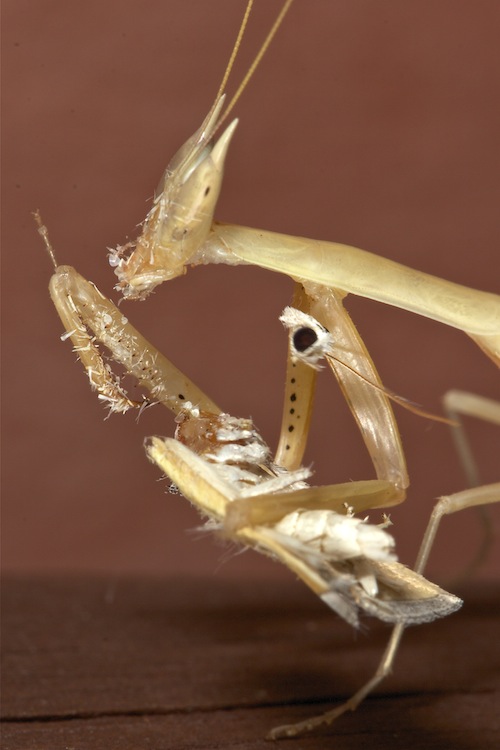
Guillotining the head also makes way for the juicier parts - the nourishing tissues that are packed inside the thorax.

Mantids are thrifty eaters and normally manage even the tough legs and head parts, their jaws chewing away from side to side, processing the food into tiny morsels that will pass down through their rather narrow gullets. A mantids menu consists of moths, butterflies, grasshoppers, flies, beetles, caterpillars and even spiders. They will also eat other mantids.
Links:
http://mantids.de/2.html
http://mantodea.speciesfile.org/Common/ ... ID=1185208
Superfamily Eremiaphiloidea. Family Eremiaphilidae. Subfamily Iridinae. Tribe Iridini

Habitat / Range
Vegetation in drier regions.
Free State, Gauteng and Northern Province, to East Africa.


Attracted to the entrance light at KK in KTP Nov. 2012

Prey and prey capture
Mantids have fierce predatory habits. They have excellent vision and extremely quick reflexes and are able to strike at and successfully capture insect prey in as little as one-twentieth of a second. They are well equipped to carry out their deadly ambush in that their front legs are liberally furnished with rows of spines. The spines on the femur are slightly tilted in one direction, those on the tibia in another direction so that when the two sections are snapped shut the prey is spiked on a kind of mobile gin-trap - no escape. The long spines on the outermost part of the tibia also act as grappling hooks as they are slung outwards over the prey's body. If suitably sized prey comes into view, the mantid slowly turns its head to view the prey and weigh up the possibilities. As soon as the mantid has judged the distance to the prey, the front legs are thrust forwards, moving as fast as lightening. The whole capture is performed with extreme precision and it is rare that prey escapes the grasp.

A mantid can strike in whichever direction its head is pointing. They are not fussy eaters and will happily munch away at anything that comes their way, even insects that share their predatory habits, such as assassin bugs and wasps.
When a mantid begins a meal, it starts with the head or neck, thus cutting out any means of struggle from its victim. This may be an important factor, especially when the prey is bigger than the mantid itself.


Guillotining the head also makes way for the juicier parts - the nourishing tissues that are packed inside the thorax.

Mantids are thrifty eaters and normally manage even the tough legs and head parts, their jaws chewing away from side to side, processing the food into tiny morsels that will pass down through their rather narrow gullets. A mantids menu consists of moths, butterflies, grasshoppers, flies, beetles, caterpillars and even spiders. They will also eat other mantids.
Links:
http://mantids.de/2.html
http://mantodea.speciesfile.org/Common/ ... ID=1185208
Re: AW Insect Book: Mantids (Mantodea) Pics & Descriptions
African Stick Mantis Popa spurca spurca
Superfamily Mantoidea. Family Deroplatyidae. Subfamily Popinae. Tribe Popini
 © BluTuna
© BluTuna
Garden in Johannesburg (March 2013)
 © BluTuna
© BluTuna
Garden in Johannesburg (March 2013)
 © BluTuna
© BluTuna
Garden in Johannesburg (March 2013)
Description
Popa spurca is known as the twig-mimicking African mantis and it has a relatively thick, stocky and elongated body.
Adult females are 7.5–8 cm in length, the smaller males are 6.5–7 cm.
Triangular head with large, laterally positioned eyes distinctive. Between the antennae there are three additional "eyes", called ocelli.
Elongated prothorax. Prothorax and abdomen are almost the same length and the cuticle is very rough and uneven.
The front legs are located in the front area of the prothorax, femur and tibia are covered with spines to hold the prey.
Taxonomic Note
The systematic position of the species of Popa was re-examined by Lombardo F. (1995) and a single species, Popa spurca is recognised. The species is differentiated into two subspecies, one being Popa spurca spurca, widespread throughout all Africa south of the Sahara, except in the east which is populated by the other subspecies, P. spurca crassa.
Distribution
Africa south of the Sahara.
Habitat
A savanna-dwelling mantid and its preferred habitat is wooded Savanna. Due to P. spurca mimicking twigs, it is assumed they live in trees, where their camouflage is beneficial in terms of catching prey and also avoiding predation.
Links:
Checklist: The Praying Mantises (Mantodea: Mantidae) of South Africa
http://mantodea.speciesfile.org/Common/ ... ID=1184951
https://specimens.mantodearesearch.com/specimen/966
Superfamily Mantoidea. Family Deroplatyidae. Subfamily Popinae. Tribe Popini
 © BluTuna
© BluTunaGarden in Johannesburg (March 2013)
 © BluTuna
© BluTunaGarden in Johannesburg (March 2013)
 © BluTuna
© BluTunaGarden in Johannesburg (March 2013)
Description
Popa spurca is known as the twig-mimicking African mantis and it has a relatively thick, stocky and elongated body.
Adult females are 7.5–8 cm in length, the smaller males are 6.5–7 cm.
Triangular head with large, laterally positioned eyes distinctive. Between the antennae there are three additional "eyes", called ocelli.
Elongated prothorax. Prothorax and abdomen are almost the same length and the cuticle is very rough and uneven.
The front legs are located in the front area of the prothorax, femur and tibia are covered with spines to hold the prey.
Taxonomic Note
The systematic position of the species of Popa was re-examined by Lombardo F. (1995) and a single species, Popa spurca is recognised. The species is differentiated into two subspecies, one being Popa spurca spurca, widespread throughout all Africa south of the Sahara, except in the east which is populated by the other subspecies, P. spurca crassa.
Distribution
Africa south of the Sahara.
Habitat
A savanna-dwelling mantid and its preferred habitat is wooded Savanna. Due to P. spurca mimicking twigs, it is assumed they live in trees, where their camouflage is beneficial in terms of catching prey and also avoiding predation.
Links:
Checklist: The Praying Mantises (Mantodea: Mantidae) of South Africa
http://mantodea.speciesfile.org/Common/ ... ID=1184951
https://specimens.mantodearesearch.com/specimen/966
Hunting cannot be considered a sport as all contestants in a sport should know they are playing the game!
AW Insect Book: Mantids (Mantodea) Pics & Descriptions
Cone-headed Mantid Empusa guttula
Superfamily Hymenopoidea. Family Empusidae. Subfamily Empusinae. Tribe Empusini
The family Empusidae is a small lineage of mantids, made up of 9 genera with only 28 described species found mostly in drier regions of Africa and a handful of additional species in southern Europe and SE Asia. It is one of the very few families of mantids known to be monophyletic, and it shows – they all share remarkable morphology that makes them stand out among other members of this singular order of insects.
Kaltenbach (1998) key to Empusid genera in Southern Africa (translated):
1a. Femora II and III without flaps, only with a small, preapical ventral fringe. Basal part of (ornament) longer than the distal part bearing lateral lamellae (?); Pronotum about 9 times as long as the (fore) coxa is wide. Males 66-80mm; females 72-89mm. .....Idolomorpha
1b. Femora II and III with subapical flaps....................2
2a. Knee-spine of femur II and III short, only slightly exceeding the apical spine. Pronotum 5-7 times as long as the (fore) coxae is broad, Males 54-62mm, females 63-80mm..........................Empusa
2b. Knee-spine of femur II and III long, much longer than the apical spine. Ponotum 7-9 times as long as the (fore) coxa is broad. Males 60-72mm, Females 65-85mm.............................................Hemiempusa
 © ExFmem
© ExFmem
 © ExFmem
© ExFmem
Kgalagadi Transfrontier Park, Urikaruus
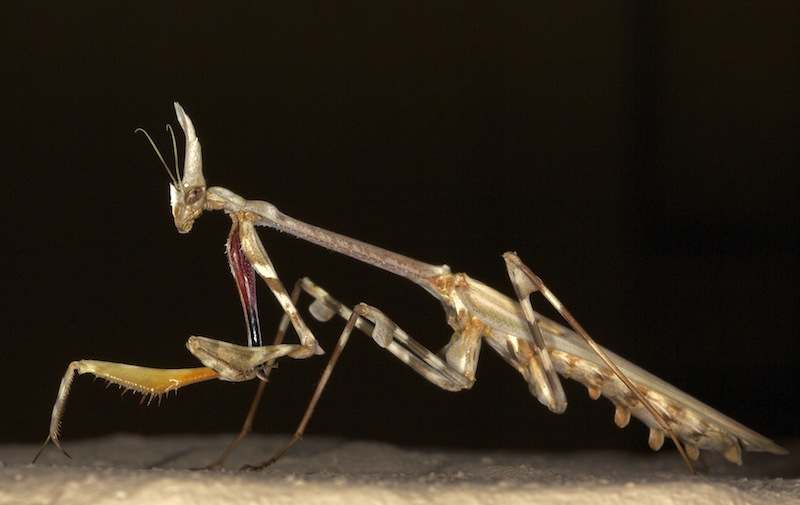
Kgalagadi Transfrontier Park
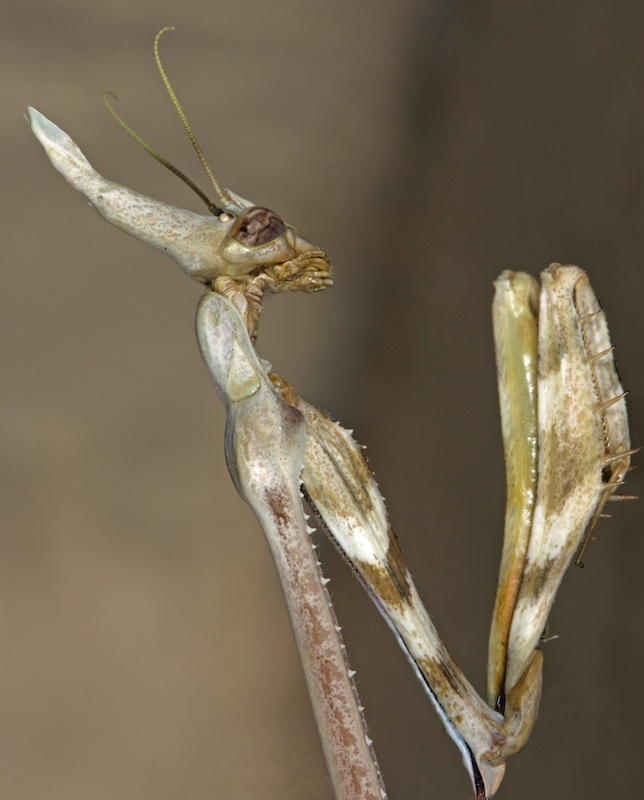
Female
Greatly elongated prothorax, laterally expanded above origin of forelegs, the expansion semi-circular and bearing teeth anteriorly.

Spines alternate along inner surface of femur of forelegs, 1 long spine following every 2 - 4 short ones.

Two main body types are common – they are either thin and stick-like or, while still being rather spindly, the body is covered with large lobes and flaps, making them excellent mimics of dried, shriveled leaves.

Habitat
Various vegetation types.


Kgalagadi Transfrontier Park, Urikaruus
Links:
http://thesmallermajority.com/2013/08/25/empusids/
http://mantodea.speciesfile.org/Common/ ... ID=1182305
Superfamily Hymenopoidea. Family Empusidae. Subfamily Empusinae. Tribe Empusini
The family Empusidae is a small lineage of mantids, made up of 9 genera with only 28 described species found mostly in drier regions of Africa and a handful of additional species in southern Europe and SE Asia. It is one of the very few families of mantids known to be monophyletic, and it shows – they all share remarkable morphology that makes them stand out among other members of this singular order of insects.
Kaltenbach (1998) key to Empusid genera in Southern Africa (translated):
1a. Femora II and III without flaps, only with a small, preapical ventral fringe. Basal part of (ornament) longer than the distal part bearing lateral lamellae (?); Pronotum about 9 times as long as the (fore) coxa is wide. Males 66-80mm; females 72-89mm. .....Idolomorpha
1b. Femora II and III with subapical flaps....................2
2a. Knee-spine of femur II and III short, only slightly exceeding the apical spine. Pronotum 5-7 times as long as the (fore) coxae is broad, Males 54-62mm, females 63-80mm..........................Empusa
2b. Knee-spine of femur II and III long, much longer than the apical spine. Ponotum 7-9 times as long as the (fore) coxa is broad. Males 60-72mm, Females 65-85mm.............................................Hemiempusa
 © ExFmem
© ExFmem © ExFmem
© ExFmemKgalagadi Transfrontier Park, Urikaruus

Kgalagadi Transfrontier Park

Female
Greatly elongated prothorax, laterally expanded above origin of forelegs, the expansion semi-circular and bearing teeth anteriorly.

Spines alternate along inner surface of femur of forelegs, 1 long spine following every 2 - 4 short ones.

Two main body types are common – they are either thin and stick-like or, while still being rather spindly, the body is covered with large lobes and flaps, making them excellent mimics of dried, shriveled leaves.

Habitat
Various vegetation types.


Kgalagadi Transfrontier Park, Urikaruus
Links:
http://thesmallermajority.com/2013/08/25/empusids/
http://mantodea.speciesfile.org/Common/ ... ID=1182305
AW Insect Book: Mantids (Mantodea) Pics & Descriptions
Hammerhead Mantid Hoplocoryphella grandis
Superfamily Holocoryphoidea. Family Hoplocoryphidae
Description
About 60 mm in length. Head hammer-shaped with small protrusions on the posterior (rear) portion of the head.
Females have reduced wings and don't fly.
Hoplocoryphella grandis looks very similar to all species in the genus Hoplocorypha. According to Giglio-Tos Hoplocoryphella can be told by the thinner body and thinner and longer pronotum. The metazone of the pronotum is almost twice the length of the coxae of the foreleg.
Links:
http://mantodea.speciesfile.org/Common/ ... ID=1185673
https://www.biodiversitylibrary.org/page/10372870
http://verlag.nhm-wien.ac.at/pdfs/100B_ ... enbach.pdf
Superfamily Holocoryphoidea. Family Hoplocoryphidae
Description
About 60 mm in length. Head hammer-shaped with small protrusions on the posterior (rear) portion of the head.
Females have reduced wings and don't fly.
Hoplocoryphella grandis looks very similar to all species in the genus Hoplocorypha. According to Giglio-Tos Hoplocoryphella can be told by the thinner body and thinner and longer pronotum. The metazone of the pronotum is almost twice the length of the coxae of the foreleg.
Links:
http://mantodea.speciesfile.org/Common/ ... ID=1185673
https://www.biodiversitylibrary.org/page/10372870
http://verlag.nhm-wien.ac.at/pdfs/100B_ ... enbach.pdf


